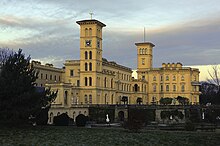
Back إحياء العمارة الإيطالية Arabic Arquitectura italianitzant Catalan Italienisierender Stil German Arquitectura italianizante Spanish سبک ایتالیاییمآب Persian Style italianisant French Italizáló építészet Hungarian Architettura italianeggiante Italian Италијански стил (неокласицизам) Serbian สถาปัตยกรรมแบบอิตาลี Thai

The Italianate style was a distinct 19th-century phase in the history of Classical architecture. Like Palladianism and Neoclassicism, the Italianate style combined its inspiration from the models and architectural vocabulary of 16th-century Italian Renaissance architecture with picturesque aesthetics. The resulting style of architecture was essentially of its own time. "The backward look transforms its object," Siegfried Giedion wrote of historicist architectural styles;[2] "every spectator at every period—at every moment, indeed—inevitably transforms the past according to his own nature."
The Italianate style was first developed in Britain in about 1802 by John Nash, with the construction of Cronkhill in Shropshire. This small country house is generally accepted to be the first Italianate villa in England, from which is derived the Italianate architecture of the late Regency and early Victorian eras.[3] The Italianate style was further developed and popularised by the architect Sir Charles Barry in the 1830s.[4] Barry's Italianate style (occasionally termed "Barryesque")[1] drew heavily for its motifs on the buildings of the Italian Renaissance, though sometimes at odds with Nash's semi-rustic Italianate villas.
The style was employed in varying forms abroad long after its decline in popularity in Britain. For example, from the late 1840s to 1890, it achieved huge popularity in the United States,[5] where it was promoted by the architect Alexander Jackson Davis.
- ^ a b Wilson, Richard Guy (2002). Buildings of Virginia: Tidewater and Piedmont. Oxford University Press. p. 517.
- ^ Siegfried Giedion, Space, Time and Architecture 1941 etc.
- ^ "John Nash Biography". BookRags.com. 13 June 1928. Archived from the original on 12 May 2006. Retrieved 18 January 2010.
- ^ Turner, Michael. Osbourne House Page 28. English Heritage. Osbourne House. ISBN 1-85074-249-9
- ^ Kibbel, Bill. "The Italianate Style". Old House Web Blog. Retrieved 18 January 2010.